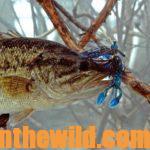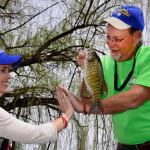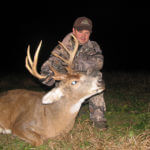Editor’s Note: Dr. Robert Sheppard of Tuscaloosa, Alabama, is the supreme student of deer and their habits. He approaches deer hunting scientifically and enjoys nothing more than gathering information about deer. This week he’s sharing with us how winds and thermals affect deer and how that impacts your deer hunting.
 Often a strong, blowing wind and a driving rain are definite advantages to successful hunting. One morning I went to my stand with a 20-knot wind in a driving rain. I spotted a buck 1/2-mile away, standing in a bean field. I had three options. I could walk straight across the bean field and spook the buck. I could circle upwind, and he’d pick up my scent. Or, I could make the 1-1/2-mile hike downwind below the buck and come up behind him. Although the stalk would be longer and a greater chance existed for him to see and hear me, the stalk was the only chance I really had. I realized too that with a favorable wind, the deer couldn’t smell me because the rain was falling so hard. Also the sound of my movement would be masked by the storm. Because everything in the woods was moving, I would fit in naturally, while moving through the forest. When I approached the buck about 50-yards away, facing the wind, he turned, walked right into the woods where I was and presented a 20-yard target. I bagged him.
Often a strong, blowing wind and a driving rain are definite advantages to successful hunting. One morning I went to my stand with a 20-knot wind in a driving rain. I spotted a buck 1/2-mile away, standing in a bean field. I had three options. I could walk straight across the bean field and spook the buck. I could circle upwind, and he’d pick up my scent. Or, I could make the 1-1/2-mile hike downwind below the buck and come up behind him. Although the stalk would be longer and a greater chance existed for him to see and hear me, the stalk was the only chance I really had. I realized too that with a favorable wind, the deer couldn’t smell me because the rain was falling so hard. Also the sound of my movement would be masked by the storm. Because everything in the woods was moving, I would fit in naturally, while moving through the forest. When I approached the buck about 50-yards away, facing the wind, he turned, walked right into the woods where I was and presented a 20-yard target. I bagged him.
Nationally-known deer hunter, the late Jerry Simmons of Jasper, Ala., often said, “I decide where I want to hunt, and then I let the wind be my friend and tell me where to hunt.”
 How to Desensitize Deer to Human Odor:
How to Desensitize Deer to Human Odor:
TV personality and nationally-known outdoorsman Bob Foulkrod of Troy, Pennsylvania, guides bowhunters and hunts on public lands. “In our part of the country, deer will feed heavily during deer season on apple trees that settlers planted years ago,” Foulkrod explains. “I’ll go into the woods 2 weeks before hunting season starts. Each day I’ll walk all the way around the apple trees I plan to hunt. Although I realize deer fear human odor, I also know they love apples. By leaving my human odor around the apple trees, the deer grow accustomed to that human odor. You can use this tactic around any of the whitetail’s favorite foods where you hunt.
 “Once deer season starts I may have to walk my hunters into their stands with the wind blowing from the wrong direction. But the deer, now acclimated to human odor, generally don’t get spooked. If the hunter’s in the tree stand, and the deer smells him, the animal usually won’t be spooked. The hunter can get off a shot. But all opportunities to shoot deer are lost, if my hunter carries a candy bar or some other unfamiliar smell that’s not human odor into his tree stand, since the deer haven’t been desensitized to those odors.”
“Once deer season starts I may have to walk my hunters into their stands with the wind blowing from the wrong direction. But the deer, now acclimated to human odor, generally don’t get spooked. If the hunter’s in the tree stand, and the deer smells him, the animal usually won’t be spooked. The hunter can get off a shot. But all opportunities to shoot deer are lost, if my hunter carries a candy bar or some other unfamiliar smell that’s not human odor into his tree stand, since the deer haven’t been desensitized to those odors.”

 To learn more information on women hunting, check out John E. Phillips’ book, “Outdoor Women’s Hall of Fame” (https://www.amazon.com/Outdoor-Womens-Hall-Fame-Premier-ebook/dp/B0771VP16V), available in Kindle and print versions. To receive your free book on “How to Make Venison Jerky,” go to https://www.emailmeform.com/builder/form/Ece3UZVcOo52cKPJcL.
To learn more information on women hunting, check out John E. Phillips’ book, “Outdoor Women’s Hall of Fame” (https://www.amazon.com/Outdoor-Womens-Hall-Fame-Premier-ebook/dp/B0771VP16V), available in Kindle and print versions. To receive your free book on “How to Make Venison Jerky,” go to https://www.emailmeform.com/builder/form/Ece3UZVcOo52cKPJcL.
















